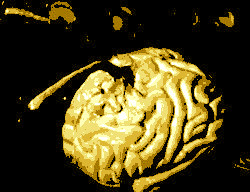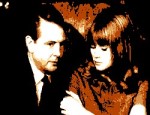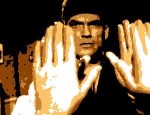Film Review
Amidst the slew of sci-fi B-movies that bombarded cinemas on both sides
of the Atlantic in the 1950s, the minor British offering
Fiend Without a Face managed to
hold its own, not because of its plot, which is drearily formulaic to a
tee, but because it boasts one of the most disgusting monster creations
ever to be projected onto a cinema screen, one which guaranteed the
film an X-certificate for its original UK release. Despite its
American feel (most of the cast hail from the United States and
Canada), the film was in fact entirely made in England, by the newly
founded independent company Amalgamated Productions. The latter
had the foresight of releasing it as part of a double bill with another
genre film it made at the same time,
The Haunted Strangler, starring
Boris Karloff. Together, these two films grossed over six hundred
thousand dollars, a more than three-fold return on the modest
production cost.
Whilst it deals with what were then endemic concerns about the dangers
of atomic power, the film was in fact based on a story written almost
three decades earlier - Amelia Reynolds Long's
The Thought Monster, which first
appeared in print in
Weird Tales
magazine in 1930. It was directed by Arthur Crabtree who had
absolutely no previous experience with the sci-fi genre and in fact
almost walked away from the film when he realised it featured
monsters. Crabtree started out as a cinematographer in the 1930s,
working on several Will Hay comedies and period melodramas for
Gainsborough Pictures, including
Fanny by Gaslight (1944).
It was whilst working for Gainsborough that he made the transition to
director with
Madonna of the Seven
Moons (1945) and
Caravan
(1946).
Fiend Without a Face
was the last but one film that Crabtree made for the cinema, followed
by
Horrors of the Black Museum
(1959).
Arthur Crabtree's antipathy for the sci-fi genre and his reluctance to
direct this particular film is apparent throughout virtually the whole
of
Fiend Without a Face.
Most of the film consists of static, unimaginatively blocked scenes
with wooden actors spewing wordy exposition and failing to look like
normal human beings as they do so. In the first half, the pace is
unbearably lethargic, the succession of stock sci-fi clichés
muddled through as routinely as someone reading out a washing list in
their sleep. Even though people keep mysteriously dying, there is
no sense of urgency or menace - it's about as exciting as a soap opera
set in a funeral parlour. But then, just when you've given up on
it, the film suddenly comes to life in its final third, as the threat
finally becomes real and the unseen monsters acquire a corporeal (and
thankfully visible) presence - but even then the actors still seem
incapable of showing any genuine emotion and just stand about looking
like shop window displays.
Fiend Without a Face would
have long passed into obscurity had it not been for its one saving
grace - the terrifying final onslaught from the 'brain creatures'
(referred to on-screen as 'mental vampires'). Based on human
brains still attached to the spinal chord, these hideous monstrosities
move with astonishing ease, zipping swiftly across the ground like
gigantic headed millipedes before hurling themselves into the air to
land on the backs of their victims, where they proceed to suck out
their brain matter. Slurp. Before we see them in all their
vomit-inducing glory, we are alerted to their presence by an ominous
heartbeat accompanied by a horrible squelching noise.
Even by today's standards, the brain creatures appear frighteningly
realistic, superbly well realised using the technique of stop motion
animation, which had been previously used on the sci-fi classics
The
Lost World (1925) and
King Kong (1933). And as
if the brain creatures were not in themselves disgusting to look at, we
are repeatedly subjected to the sight of them being exploded by
bullets, their insides spilling out in one gory, stomach-turning mess
that is guaranteed to put you off your next meal. With so little
going for it on the writing, acting and directing fronts,
Fiend Without a Face has minimal
chance of rating as a sci-fi classic, but it scores sufficiently highly
on the yuk-factor scale to justify a mention in any self-respecting
catalogue of horror films.
© James Travers 2015
The above content is owned by frenchfilms.org and must not be copied.
Film Synopsis
A U.S. airbase in Canada is resented by the inhabitants of the nearby
town of Winthorp, who insist that noise from jet aircraft is adversely
affecting livestock and milk yields. Senior staff at the airbase
are more concerned with recurring power drains to its atomic reactor,
which have started disrupting the deployment of a new radar system that
can reach as far as Siberia. And then the killings start.
The victims are found in the vicinity of the airbase,
with their brains and spinal chords missing. It isn't long before
the base's atomic reactor is blamed for these strange deaths. In
the course of his investigation, Major Jeff Cummings meets Professor
Walgate, who has retired to the area ostensibly to write a book.
In truth, Walgate has been secretly conducting experiments to prove his
theory that solid objects can be moved by the power of thought
alone. In the course of his experiments, Walgate has created an
invisible monster that feeds on human brains, absorbing power from the
air base's atomic reactor to grow and multiply...
© James Travers
The above content is owned by frenchfilms.org and must not be copied.



